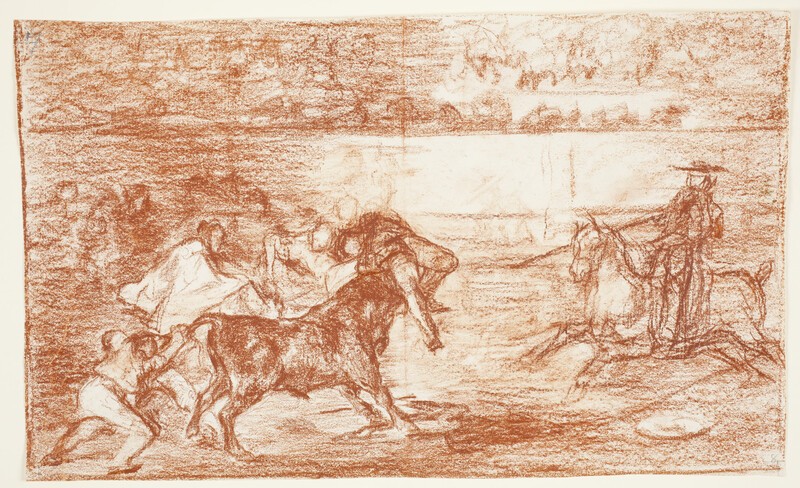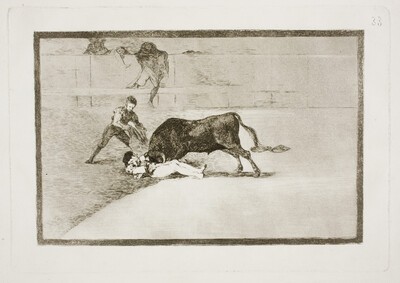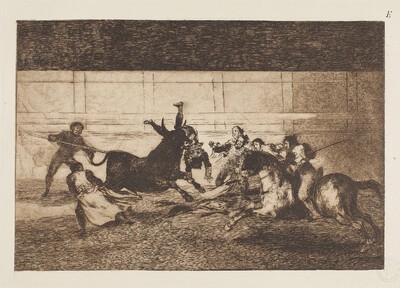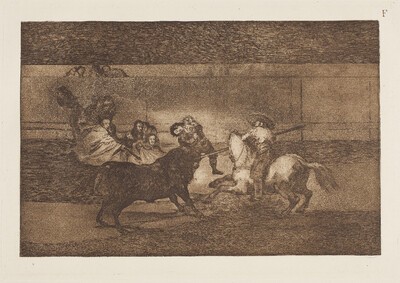- Cronología
- Ca. 1814 - 1815
- Ubicación
- The Prado National Museum. Madrid, Madrid, Spain
- Dimensiones
- 192 x 320 mm
- Técnica y soporte
- Reconocimiento de la autoría de Goya
- Documented work
- Titular
- El Prado National Museum
- Ficha: realización/revisión
- 03 Oct 2021 / 22 Jun 2023
- Inventario
- (D4324)
- Otros títulos:
-
8 (in pencil, bottom right-hand corner)
7 (in pencil, upper left-hand corner)
246 (reverse, lower part)
Engraved but unpublished (reverse, upper central part)
See How the ancient Spaniards hunted bulls on horseback in the countryside.
This preparatory drawing passed by inheritance in 1828 to Javier Goya, the painter's son, and in 1854 to Mariano Goya y Goicoechea, the artist's grandson. It was subsequently owned by Valentín Carderera (ca. 1861) and Mariano Carderera (1880). In 1886 it was acquired from Mariano Carderera, along with many other drawings by Goya, including almost all the preparatory studies for the Bullfight, by the Directorate General of Public Instruction, and was assigned to the Prado Museum, where it entered on 12 November 1886.
See How the ancient Spaniards hunted bulls on horseback in the countryside.
Preparatory drawing for the print The Death of Pepe Illo (Bullfighting F). It is also related to the engravings The Death of Pepe Illo (Bullfighting E) and The Unfortunate Death of Pepe Illo in the Bullring in Madrid, as they deal with the same subject: the death of the bullfighter Pepe Illo in the bullring in Madrid on 11 May 1801.
This drawing, although a preparatory drawing for the above-mentioned print, differs somewhat from it in its rapid strokes and with a large number of figures. In fact, it shows a slightly earlier moment of the bullfighter's death. In this case we see how the bull, with the bullfighter nailed to the horn, appears on the left of the composition, while two figures grab him by the tail to see if he will let go of the master, figures that will disappear in the later engraving. On the right of the drawing we see a picador on horseback with a pike in his hand, heading straight for the bull to whip him and try to get him to release the bullfighter. In contrast to the later print, he is not yet poking the bull.
The light falls on the scene from right to left, illuminating it diagonally. This is a drawing that does not dwell much on the details of the figures, except for the bull, reflected in full movement, and the horse, although in the latter Goya did not make as much of an anatomical study as in the former. The rest of the figures are simply sketched.
Gassier points out that the pathos of the scene is greater in the engraving due to the grouping of the figures in the centre of the composition.
The paper retains creases from being passed through the press.
-
Goya. Exposition de l’oeuvre gravé, de peintures, de tapisseries et de cent dix dessins du Musée duBibliothèque nationale de FranceParís1935cat. 276
-
Madrid1990cat. 55
-
Ydioma universal: Goya en la Biblioteca NacionalBiblioteca NacionalMadrid1996from September 19th to December 15th 1996cat. 270
-
1946pp. 177-216, espec. pp. 212-213
-
MadridMuseo del Prado1954cat. 190
-
ParísLe Club Français du Livre1963p. 177
-
Vie et ouvre de Francisco de GoyaParísOffice du livre1970p. 280, cat. 1230
-
Barcelona1974p. 20
-
The Changing image: Prints by Francisco GoyaBostonMuseum of Fine Arts1974pp. 244-247
-
Dibujos de Goya, 2 volsBarcelonaNoguer1975pp. 414-415, cat. 282
-
El mundo de Goya en sus dibujosMadridUrbión1979pp. 209-210
-
Ydioma universal: Goya en la Biblioteca NacionalMadridBiblioteca Nacional, Sociedad Estatal Goya 96 y Lunwerg1996pp. 244-245
-
MadridMuseo Nacional del Prado2001pp. 105-106



